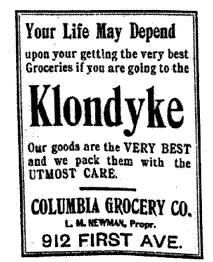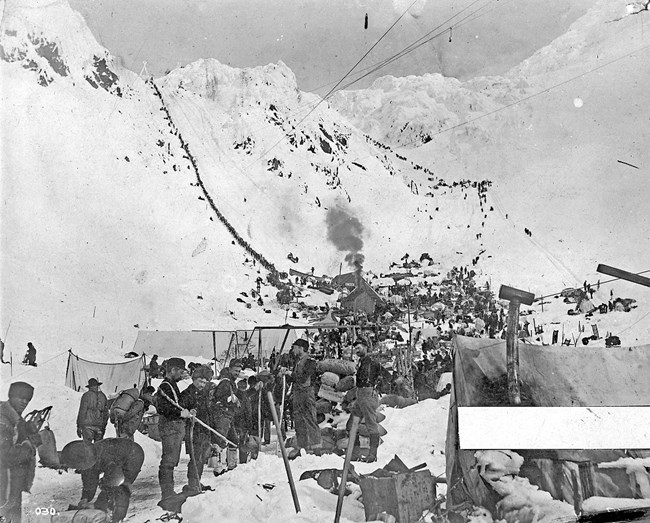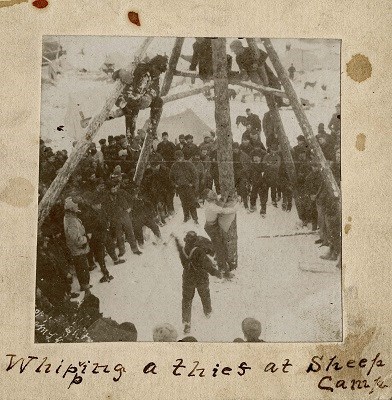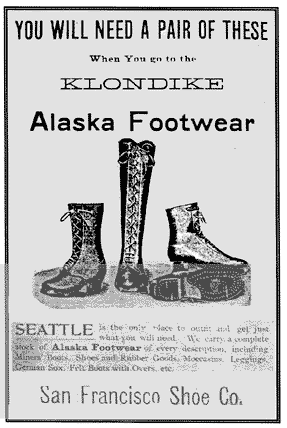
National Park Service, Klondike Gold Rush National Historical Park, George and Edna Rapuzzi Collection, KLGO 55746a. Gift of the Rasmuson Foundation. 
Why take a ton of goods?
To prevent mass starvation in the remote and inaccessible Yukon Territory, the Canadian government required every stampeder bring a year's supply of goods before crossing the border.
As people headed to the Klondike, few of them had any idea what they were getting themselves into. Fueled by dreams of gold and pure ambition, they set sail on an adventure most were not properly prepared for. Without modern communication systems, stampeders had to rely on hearsay and advertisements to let them know what they needed in the north.
Within days after the arrival of the first gold ship in San Francisco, observers were expressing concern about what would happen if a hoard of new arrivals got to Dawson in the fall. With a long supply chain stretching the length of the Yukon River to west coast ports like San Francisco or Seattle, getting extra food to Dawson before winter was problematic.
The Canadian government determined each person going to Dawson from Skagway or Dyea needed three pounds of food per day for a whole year. Food alone would weigh in at a minimum of 1,095 pounds (~497 kg) or just over half a ton. But for a prospector, adding necessary clothes and equipment to the food could easily double the total load, and thus came to be known as a "ton of goods." If purchased in the U.S., the goods were subject to customs duties payable to the North-West Mounted Police who also enforced the amount of goods required. Just between February and June of 1898, the Mounties collected $174,000 in duties. In today's money, that is about $4.9 million dollars! 
National Park Service, Klondike Gold Rush National Historical Park, George and Edna Rapuzzi Collection, KLGO 55832a. Gift of the Rasmuson Foundation. Transporting a ton of goods "Stacey and I viewed our hundreds of pounds of supplies with much concern, especially when we saw the steep, slippery trail leading from the river up the canyon. We knew we would have to make a number of back-breaking relay trips to establish our first cache. Quickly, we began dividing our supplies, making about sixty-five to seventy-pound packs for each. Then we started. The trail immediately crooked up, narrow and slippery. As we climbed, we threw our weight toward the inside of the trail, hugging the precipitous walls. The fact that we must make several trips over this trail for the rest of our supplies was hard to bear." - Stampeder Ed Lung, 1897. At first some stampeders hired local packers to help them transport their gear. "The scales mark the point at which goods are weighed previous to being taken from here to the summit, the charges for transport by packing from this point upward being very much in excess to prior ones." - Sgt. Yanert, March 1898 Many Tlingits were contracted to move gold rush gear and made good money working the trails. As the rush wore on, non-native packers, pack animals, tramways, and eventually a railroad were available as options for crossing the passes with supplies. Each method had its advantages and disadvantages. As fewer Tlingits worked the trails, local knowledge of the area and weather conditions was lost to the misfortune of many on the trail. On April 3, 1898, an avalanche killed many stampeders on the Chilkoot Trail who continued to pack even after the Tlingits had quit due to the dangerous conditions. 
National Park Service, Klondike Gold Rush National Historical Park, George and Edna Rasmuson Foundation, KLGO 55811. Gift of the Rasmuson Foundation. Guarding your gear "Preparations being made for crossing the Chilkoot today. We secured about fifty packers who started for the summit with packs. It was not sufficient number to take all our baggage...."
Some stampeders may have used their money to buy the assistance of people to guard their supplies. Tappan Adney describes hiking the Chilkoot Pass in September 1897, "each [of us] with packs of stuff that we could not trust to packers, leaving the boat lumber in [the] charge of a trustworthy man." Nevertheless, some thefts did occur. Everett Barton described one early in September 1897: "A man was caught stealing at Deya [sic] yesterday and was shot three times. A fellow stole a watch here yesterday and the people held a meeting to see what to do with him but I have not heard." Regulating groups were often established in some of the more concentrated areas to hand out punishments for rare crimes along the trail. Tappan Adney described one so-called court at Sheep Camp in the fall of 1897: "The court-house was a ten-by-twelve tent. The commissioner or judge sat on a goods-box with a larger goods-box in front, and the lawyers and defendants and plaintiffs, numbering about a dozen persons, sat on other boxes and discussed the situation informally…. A settlement was arrived at in each case. There is not much law. Common-sense rules, or tries to." What should you take to the Klondike in 1897-1898? 150 lbs. bacon 
Six 8 inch files and two taper files for the party Draw knife, brace and bits, jack plane, and hammer for party 200 feet three-eights-inch rope
8 lbs. of pitch and 5 lbs. of oakum for four men Nails, five lbs. each of 6,8,10 and 12 penny, for four men Tent, 10 x 12 feet for four men Canvas for wrapping Two oil blankets to each boat 5 yards of mosquito netting for each man 3 suits of heavy underwear 1 heavy mackinaw coat 2 pairs heavy machinaw trousers 1 heavy rubber-lined coat 1 dozen heavy wool socks 1/2 dozen heavy wool mittens 2 heavy overshirts 2 pairs heavy snagproof rubber boots 2 pairs shoes 4 pairs blankets (for two men) 4 towels 2 pairs overalls 1 suit oil clothing Several changes of summer clothing Small assortment of medicines |
Last updated: August 6, 2024
